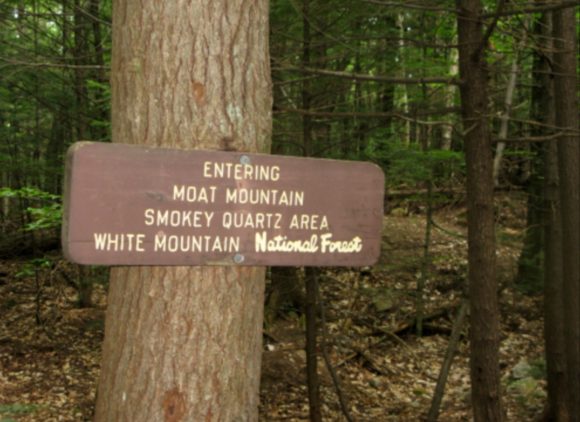
Welcome to Moat Mountain! Here is beautiful example of the typical smoky quartz and microcline combo found at this locality.
For more info and directions, Nat’l Forest Service page: https://www.fs.usda.gov/Internet/FSE_DOCUMENTS/stelprdb5382896.pdf
Background:
The iconic New Hampshire locality, Moat Mountain has been popular for its gorgeous smoky quartz and microcline specimens for decades. New Hampshire is known as “The Granite State” so it is fitting that specimens at its signature locality occur in a granite. In many ways, these specimens bear resemblance to other granitic quartz and feldspars from throughout the US, such as those from Colorado and Montana. The association of smoky quartz and feldspar is very typical in a miarolitic granite. More about how exactly these crystals form later.
One of the few if only free, open to the public dig sites in New England where pocket smoky quartz crystals can be found, this location is maintained by the National Parks Service and is accessible from mid spring to early autumn. The severe winter weather in the area makes collecting during that time impossible. Nearly the entire mountain has various mineral locations for smoky quartz, amethyst, microcline, and fluorite, but please respect where the parks service allows and doesn’t allow digging.
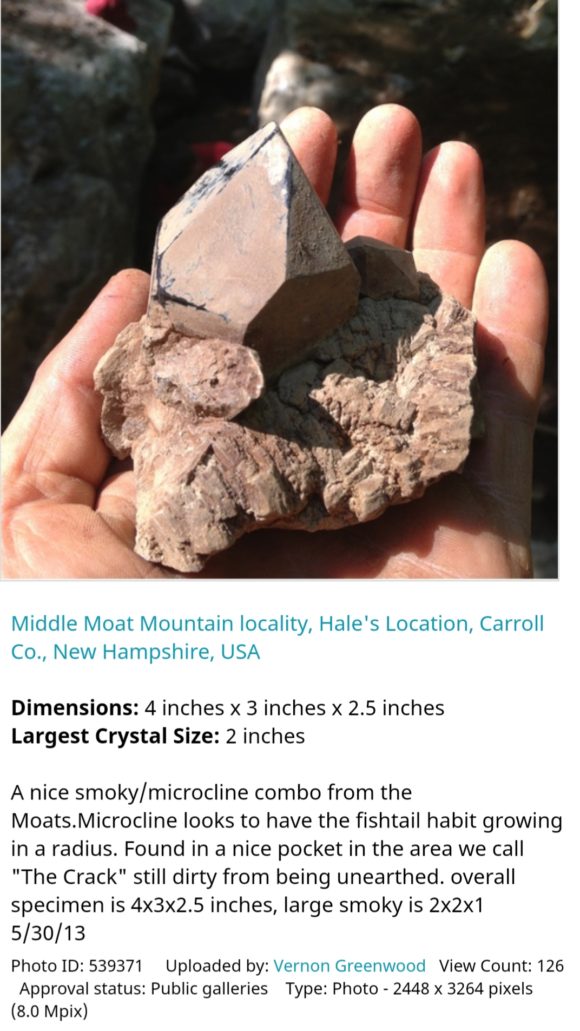
Geology and Minerals:
This locality occurs in miarolitic granite and these crystals are over 200 million years old. The minerals at this location formed at the contact between the Conway granite and the Moat Mountain volcanics. These volcanic rocks were part of a very active ancient volcano. As they rose and depressurized, gasses escaping from them were trapped by the surrounding Conway granite, forming the smoky quartz, microcline, and other minerals. The chemistry of the gasses was pretty simple, but enriched in fluorine which gave rise to some of the rarer, highly collectible minerals at the site.
Minerals:
Smoky Quartz: Commonly found in miarolitic pockets. Gemmy, very lustrous smoky quartzes are abundant. Usually they are an inch or less, but crystals to over a foot have been found. Some of the Moat Mountain pockets have been massive. It is still possible to find large pockets here, but it requires a lot of both work and luck.
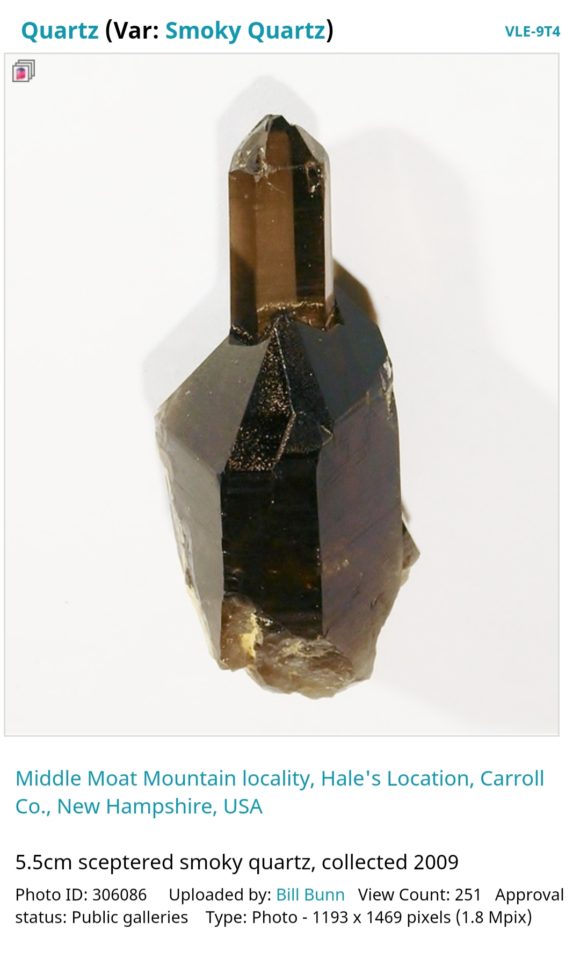
Some fantastic examples on Mindat of smokies collected at Moat. Note the red mud on the freshly pulled piece. These gorgeous specimens are proof good finds at Moat can still be made.
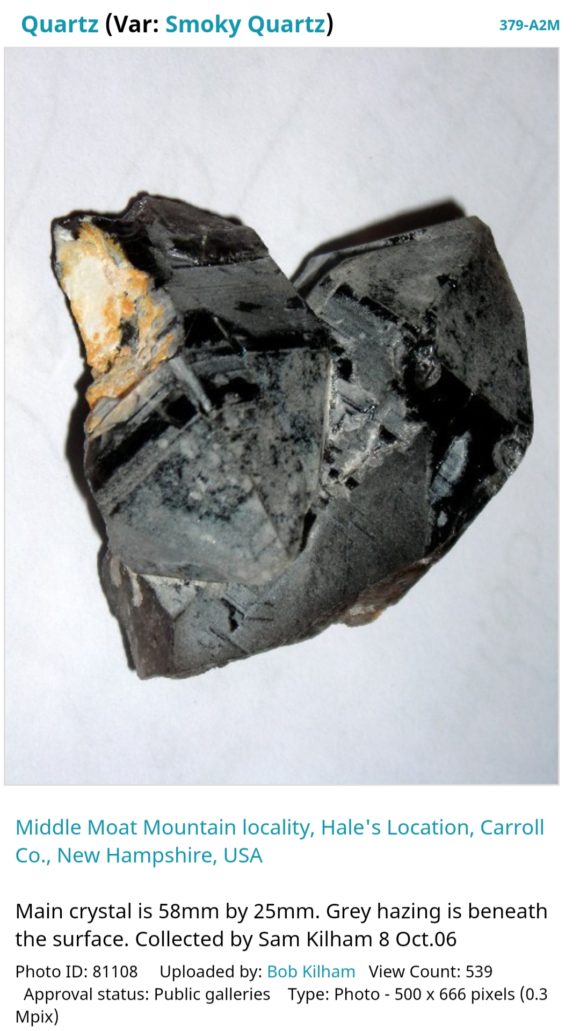
Fine Smoky Quartz Crystal from the Granite of New Hampshire
Microcline: Blocky crystals of microcline provide the matrix for many smoky specimens. They represent the walls of the miarolitic cavities. Often overlooked, these microclines make fine specimens on their own. Beautiful blue green amazonite and Baveno twinned crystals have been found on occasion.
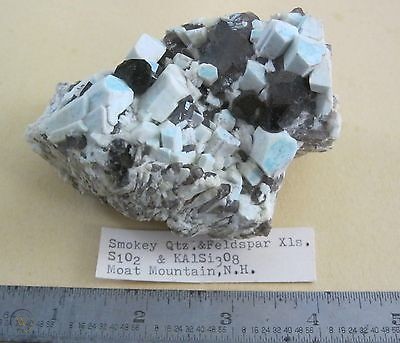
Old school specimen of smoky and amazonite from Moat Mountain
Topaz and Fluorite: The ultimate Moat Mountain specimen is a fine topaz, however this mineral is extremely rare here. When found, it is known to produce gorgeous gem quality champagne, pale blue, or colorless crystals that are sometimes slightly etched. Specimens can exceed five centimeters.
Fluorite crystals to several centimeters in diameter have been found on Moat Mountain. Also a rarity, they are quite sought after. Fluorite is a fragile, sensitive mineral so it often weathers away if it is at all present in a pocket. It occurs primarily in green, blue, and purple at this locality and can form cubic or octahedral crystals.
Directions (From Forest Service):
From West Side Road in Conway turn onto Passaconaway Road. Travel 1.2 miles and turn right onto High Street (dirt road). This road leads into the White Mountain National Forest, passing a gate at 1.4 miles. At 1.7 miles, bear left and continue 0.7 miles to the parking area at the end of the road. The Moat Mountain Mineral Collecting Site is a 0.9 mile hike from the parking area. On the Mineral Site Trail, keep right at both branches.
GPS Coordinates: • Moat Mineral Collecting Site Trailhead: 44.021700, -71.169500
Collecting Tips: There are many ways to collect this material. A popular way is to dig through loose, weathered rock paying attention for crystals and pocket sections. A hand rake and shovel are good for this. It pays to dig deep, past areas that have already been searched.
Another method is searching ledges for pockets and working the rock. Observe how plants grow, often roots will follow crystal bearing pockets and seams because they are open space easy for them to take hold in. Breaking the granite is hard work and requires a lot of hammering and chiseling. An assortment of wedges, chisels, hammers, and prybars would be a good idea to bring. Use large, flat wedges to exploit cracks in the rock.
This location is remote, so bring food, water, and bug spray especially if you plan on staying there for a while.